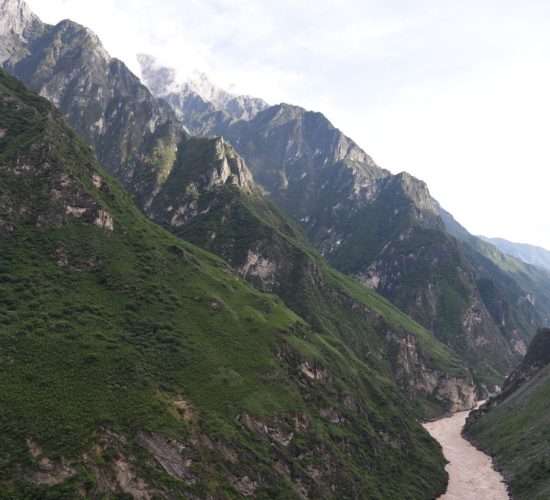According to Ci Ta, age 86. Told by “Tashi”, his grandson


When the blond haired and blue eyed missionaries of Europe arrived in Yanjing, the Tibetan people thought they were wicked. They filled every description of devils according to the Buddhist tradition, with their fair skin, hair and light eyes. So the people were suspicious and protective of their territories. The missionaries struggled for almost six hundred years to make inroads, until finally French priests (around 1860, possibly Dutch Évariste Regis Huc /Duke/ and others in 1840’s) were able to negotiate passage along the Tea and Horse Road, for the price of three donkeys packed with money.
The French priests, now growing rather well-known for their wealth and exotic European gear, went to the Tibetan monastery in Yanjing accompanied by an entourage of local guards, who left them there. They entered the monastery offering to share their rifles, hand-guns and binoculars. While the lamas were not terribly interested in the guns, the binoculars fascinated them because with these they could see the beard on the chin of a goat at a great distance.
The lamas were also fascinated by their “tongue”, Duke (most likely É. R. Huc) and his confreres (most likely Fr. Joseph Gabet) learned ability to speak Tibetan and other languages. They invited the two to engage in a language exchange for over two years, during which time these “white lamas” as they were called, on account of their skin color, compiled a Latin-Tibetan dictionary to further enhance their mutual understanding.
The Fathers wanted to build a church in Yanjing, but the lamas were skeptical, so they called in a government official to mediate. This was near the end of Ching dynasty and imperial power was waning. The Ching magistrate sided with the French as a last-ditch effort to maintain power in the glow of the European presence in the trading post.
The priest said he wanted a piece of land only the size fo a yak skin for this church, to which the lamas laughed and squinted, and reluctantly agreed. Summarily, the father went and stretched the skin and then cut it into strips which he stretched around the periphery of the monastery. It was the worst deal the lamas ever made.


The church was built with excellent feng shui and soon Fr. Huc wanted to build a bell-tower. This made the lama rather angry. The priests were of course eager to bring people to the monastery, and a bell would certainly attract them.
The first convert to Catholicism in the region was an orphan boy whom the fathers had found by the river. He became Catholic at the age of 20. For the lamas It was remarkable, even rather unthinkable, to intervene in the fate of a young man found by the river. He was there as it was meant to be for him. After all, this life is your fate. The boy would have a better chance, reincarnated in his next life. But the Catholics believe in the dignity of every person, every human-being, and so they help the poor and the orphan and the widow.
The orphan, filled with gratitude said, “Thank you” to the priest.
To which the priest replied, “Don’t thank me, thank God.”
That was the first time the name “God” was spoken in the Tibetan language. The orphan went out and told his friends what had happened to him and invited them to come and see. They were interested. Some Tibetans don’t like Buddhism because you are “stuck” in reincarnation. You can never really get to a better place.
The second convert was a robber from Sichuan province. He did not want to be reincarnated as a cockroach or rat. Fr. Huc told him to repent. And so he did, as best he could.
There were many lepers along the Tea Horse Road. There was no cure in China at that time, but the Europeans understood how it was spread and how to treat it. The leapers also wanted to convert.
There were also many plagues in China, thought to be used by devils. Rats as big as rabbits abounded, often blocking the way along the trade-road. People asked the lamas to pray, may it help. But, the Europeans understood that fleas caused the plague and they had medicines to treat the sick, to get rid of the demons. The Tibetans were people of great gratitude and they too wanted to convert.
Why did some of the Tibetans convert to Catholicism? Tibetan Buddhism counts reincarnation and the wheel of life as part of its core principles. For some Tibetans, especially those that were downtrodden and impoverished, the traditional belief was that the workings of bad karma and reincarnation had confined them to a miserable life. Catholicism appealed to them, because it freed them from the shackles of reincarnation and the wheel of life while providing help and sustenance similar to what Buddhism promised. To some of the Tibetans who were exposed to Catholicism, both religions seemed to have the potential to serve the human good.

Slowly, as these converts embraced their newfound beliefs in Catholicism, they also stopped making offerings to the Buddhist monastery, which irritated some of the monks. Some of these upset, disgruntled monks sewed seeds of conflict. They went to the Senior Lama to complain. But he refused to take action, seeing that the Catholics were compassionate and doing mostly the same as they were in the lamasery. He wanted to keep the peace.
Then, some of the monks started throwing stones, breaking windows of the church and finally in the early 1900’s the church in Yanjing caught fire. (Five years later the church in Cizhong also caught fire – Rebuilt in the photo here) and soon the battling grew fierce. The Catholics moved to the other side of the river, the Naxi side, and there they built a new church, also called Yanjing, just on the other side of the river, the Naxi side.
There was a Naxi family from Lijiang, the Mu family, who fought the Tibetans and wanted to control the region, but never succeeded. The Tibetans, to the degree that they were compassionate Buddhists, allowed the Mu to stay in the region if they desired. But the Tibetans imposed very strict restrictions on them, almost impossible to abide. To this day, they are not allowed to marry a Tibetan, and they are only allowed to farm land above the climbing height of a yak. That is the worst land, very steep and almost impossible to farm.
The Catholics, having suffered much in the destruction of their churches and constant attacks, decided to pursue a new way with the Naxi people. They set out to learn their culture and their language and they sought compensation, which they were given for the burning of the first church in Yanjing. Meanwhile the Naxi were clever people, engaged in the mining of salt. Yanjing means, after all, “salt”, a precious commodity, known for its mineral rich, pink color. Frequently the priests had to intervene to negotiate over salt between the Naxi and Tibetan people.
The priests wanted to get close to the Naxi, but the people were stubborn. They were strong believers in their Dongba religion. So the priests even tried to learn Dongba language and religion to build better understanding.
The priest in the new church in Naxi Yanjing, on this new side of the river, dug a number of tunnels under this church. There the church housed scriptures of Dongba religion, written on sticks. These artifacts eventually were taken to France, where they can be found in the National Library and also in the British Museum.
Some Tibetan Buddhists believe that the next Buddha will be born, re-incarnated into the life of a Naxi Catholic family. They continue to search and wait for signs of this.
The Austrian-American explorer Joseph Rock, whose home we saw in Lijiang, met the French priests in Naxi Yanjing. (Pictures of his meeting with the missionaries in Xiaoweixi Catholic Church, in Tongwei village, might be among those we saw there). He was a botanist, fluent in Latin, who grew up in a Catholic family, and whose father wanted desperately for him to become a priest. Anyway he made a circle including Yanjing, Luguhu Lake and Bing Zhong Lou village, just over the mountain from Cizhong on the “Angry” river, the Nou (Salween) river.
There have been several expeditions, even in recent years, by French and other Europeans, Catholics, wanting to learn this history and to walk in the footsteps of these missionaries.* The missionaries brought grapes and walnuts from France to this part of China. The French who have come, have brought walnuts from these trees, with their origins in France, back to their home country, as souvenirs and pieces of the missionary story. Similarly, we have the explorer and botanist, Joseph Rock to thank for bringing rhododendron species from China to Europe.
The Tibetan people have a rich tradition of chanting (called Tuva, tonal chant, which we also heard in the Catholic church in Cizhong). The Naxi believe that there are 18 levels of Hell, which they must chant their way through after they die. As the cultures have blended, perhaps this is why they chant as they do, beginning in this life, even in the Catholic church here in this Tibetan region.
By: Michelle Mope Andersson D.Min.
Cultural Curator
Pastoral and Existential Wellness Counselor
An Oral History of the Catholic Missionaries in the Tibetan Region
Originally posted on www.mopeandersson.com











